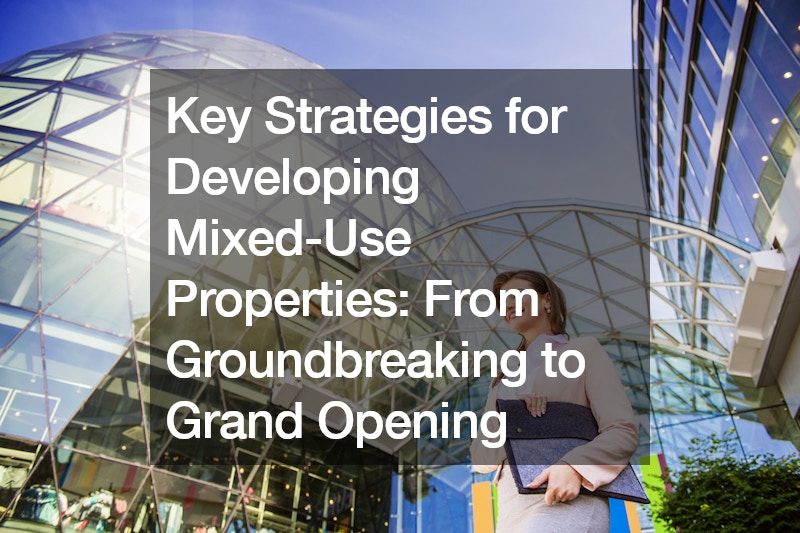The development of mixed-use properties is becoming increasingly popular among investors due to their potential for high returns and the creation of vibrant, multifunctional communities. These developments blend residential, commercial, and sometimes industrial spaces into a cohesive unit, offering convenience and diverse amenities to residents and businesses alike. However, the successful development of such properties requires meticulous planning, coordination with various professional services, and adherence to strategic steps from the initial groundbreaking to the grand opening. This article explores the key strategies for developing mixed-use properties, providing actionable advice to help investors navigate the complexities of these projects effectively.
Planning and Site Preparation

Effective planning and site preparation form the backbone of any successful mixed-use property development. This critical phase involves a comprehensive assessment of the site, obtaining necessary permits, and clearing the land to make way for construction. From selecting the right building contractor to managing vegetation and ensuring the site is ready for development, these initial steps set the stage for the entire project. Proper planning and site preparation not only ensure compliance with local regulations but also pave the way for a smooth construction process, ultimately leading to a successful and profitable mixed-use property.
Engaging Professional Contractors
The foundation of any successful mixed-use development lies in the selection of a reputable building contractor. This professional will oversee the entire construction process, ensuring that the project adheres to design specifications, budget constraints, and timelines. When choosing a contractor, investors should consider factors such as experience with similar projects, reputation within the industry, and the ability to manage large-scale, multifaceted developments.
Tips for Selecting a Building Contractor:
- Experience and Expertise: Look for contractors with a proven track record in mixed-use developments. Their experience will ensure they understand the unique challenges and requirements of these projects.
- References and Reviews: Check references and online reviews to gauge the contractor’s reliability and quality of work. Speaking with previous clients can provide valuable insights.
- Comprehensive Services: Opt for a contractor who offers comprehensive services, including project management, procurement, and quality control, to streamline the construction process.
Clearing and Preparing the Land

Before construction begins, the site must be adequately prepared. Land clearing contractors play a crucial role in this phase, removing obstacles such as trees, rocks, and old structures to create a safe and functional building site. Proper land clearing not only facilitates construction but also ensures compliance with local regulations and environmental standards.
Steps in Site Preparation:
- Site Assessment: Conduct a thorough site assessment to identify any potential challenges, such as unstable soil or protected vegetation.
- Permits and Approvals: Obtain the necessary permits and approvals from local authorities to ensure the land clearing process is legally compliant.
- Professional Land Clearing: Hire experienced land clearing contractors to handle the job efficiently and safely. They will use specialized equipment to clear the land without causing unnecessary environmental impact.
Managing Vegetation and Tree Removal
The removal of trees and other vegetation is a critical step in site preparation. Tree removal contractors are responsible for safely and efficiently removing trees that obstruct the construction area, while also preserving the health of the surrounding environment. This process must be handled with care to avoid damaging the ecosystem and to comply with environmental regulations.
Strategies for Responsible Tree Removal:
- Tree Surveys: Conduct a tree survey to identify which trees need to be removed and which can be preserved.
- Sustainable Practices: Use sustainable practices, such as relocating certain trees or using the wood for construction purposes.
- Regulatory Compliance: Ensure all tree removal activities comply with local environmental regulations and obtain necessary permits.
Infrastructure and Utilities

Infrastructure and utilities are the lifelines of any mixed-use property development, ensuring that the building is functional, safe, and efficient. This phase involves the meticulous planning and installation of essential systems such as electricity, water, and safety mechanisms that support both residential and commercial tenants. A well-designed infrastructure enhances the property’s value and appeal by providing reliable services and minimizing operational disruptions. This section delves into the critical aspects of establishing robust infrastructure and utilities, including the importance of energy-efficient electrical systems, the installation of essential safety systems like fire alarms, and the strategic use of heavy machinery for large-scale tasks. By focusing on these key components, investors can ensure their mixed-use buildings are not only compliant with local regulations but also equipped to meet the demands of future occupants, fostering a secure and comfortable environment for all.
Ensuring Reliable Electrical Systems
Electrical systems are the backbone of any mixed-use development, providing power to residential units, commercial spaces, and common areas. Commercial electrical contractors are essential in designing and installing these systems to ensure they are efficient, safe, and scalable.
Key Considerations for Electrical Systems:
- Energy Efficiency: Implement energy-efficient solutions, such as LED lighting and smart thermostats, to reduce operational costs and environmental impact.
- Safety Standards: Adhere to the highest safety standards to prevent electrical hazards and ensure the well-being of occupants.
- Future-Proofing: Design electrical systems that can accommodate future expansions or technological upgrades.
Installing Essential Safety Systems
Safety is paramount in mixed-use developments, where a high density of occupants and varied usage can increase risks. Installing commercial fire alarms is a critical component of the safety infrastructure. These systems must be reliable, easy to maintain, and compliant with local fire codes.
Steps for Effective Fire Alarm Systems:
- Assessment and Planning: Conduct a comprehensive risk assessment to determine the optimal placement of fire alarms.
- Compliance: Ensure the fire alarm system meets all local building codes and safety regulations.
- Regular Maintenance: Establish a maintenance schedule to regularly test and service the fire alarm system, ensuring it remains operational at all times.
Construction and Development

The construction and development phase is where the vision of a mixed-use property begins to take tangible form. This stage encompasses the physical building process, from the foundational work to the final touches that make the property functional and appealing. Effective construction management requires coordinating various professional services, ensuring adherence to design specifications, and maintaining rigorous safety standards. Critical aspects of this phase include utilizing heavy machinery, such as cranes, to handle large-scale construction tasks efficiently, and ensuring that the roofing is durable and weather-resistant to protect the investment. Additionally, focusing on quality craftsmanship and integrating sustainable practices can significantly enhance the property’s long-term value and appeal. This section explores the essential strategies and considerations involved in the construction and development of mixed-use buildings, providing actionable advice to help investors navigate the complexities of building a successful and profitable development. By understanding and implementing these key strategies, investors can ensure their projects are completed on time, within budget, and to the highest standards of quality.
Utilizing Heavy Machinery and Equipment

Large-scale construction projects often require heavy machinery, such as cranes, to lift and move materials. Utilizing the services of a crane rental company can provide the necessary equipment without the significant capital expenditure of purchasing it.
Key Considerations for Crane Rentals:
- Equipment Selection: Choose cranes that are appropriate for the specific tasks and conditions of your site.
- Operator Expertise: Ensure that the rental company provides skilled operators who are trained in safety protocols and efficient operation.
- Logistics and Planning: Coordinate with the crane rental company to plan the logistics of crane use, including delivery, setup, and operation timelines.
Roofing Solutions for Durability and Weather Resistance
The roof of a mixed-use property must be durable, weather-resistant, and aesthetically pleasing. Commercial roofing companies specialize in installing and maintaining high-quality roofing systems that protect the building and enhance its appearance.
Tips for Selecting Roofing Solutions:
- Material Selection: Choose materials that are durable, energy-efficient, and suitable for the local climate.
- Professional Installation: Hire experienced commercial roofing companies to ensure proper installation and adherence to safety standards.
- Regular Inspections: Schedule regular roof inspections to identify and address any issues before they become major problems.
Aesthetic and Functional Enhancements

Aesthetic and functional enhancements are pivotal in transforming a mixed-use property from a mere structure into a vibrant, attractive, and practical space. This phase focuses on the finer details that enhance both the appearance and usability of the property, creating an inviting environment for residents, businesses, and visitors alike. Effective landscaping can significantly boost the property’s curb appeal, while thoughtfully designed signage ensures that the various components of the development are easily navigable and visually cohesive. Additionally, incorporating outdoor amenities and green spaces enhances the property’s functionality and allure. This section delves into the strategies for integrating these enhancements, emphasizing the importance of working with professional landscaping companies and local sign companies. By focusing on both aesthetics and functionality, investors can create a mixed-use property that stands out in the market, attracts high-quality tenants, and fosters a sense of community. These enhancements not only add immediate value but also contribute to the long-term success and desirability of the development.
Designing Attractive and Functional Outdoor Spaces
Outdoor spaces are a significant aspect of mixed-use properties, providing recreational areas for residents and appealing environments for businesses. Landscaping companies can help design and maintain these spaces to enhance the property’s overall aesthetic and functionality.
Tips for Effective Landscaping:
- Integrated Design: Create a cohesive design that integrates seamlessly with the building’s architecture and surrounding environment.
- Sustainable Practices: Use sustainable landscaping practices, such as native plantings and efficient irrigation systems, to reduce maintenance costs and environmental impact.
- Amenities: Incorporate amenities like seating areas, walkways, and green spaces to enhance the usability and appeal of outdoor areas.
Creating Effective Signage
Effective signage is crucial for wayfinding, branding, and attracting tenants and customers. Local sign companies can design and install signage that is both functional and visually appealing.
Strategies for Signage Design:
- Visibility and Readability: Ensure signs are easily visible and readable from a distance, with clear fonts and contrasting colors.
- Brand Consistency: Maintain consistency with the property’s branding in terms of colors, fonts, and logos.
- Durability: Choose materials that are durable and weather-resistant to ensure longevity.
Final Preparations and Maintenance

As a mixed-use property development nears completion, final preparations and ongoing maintenance become crucial to ensure a smooth transition from construction to occupancy and long-term operational success. This phase involves meticulous attention to detail, ensuring that every aspect of the property is fully functional, aesthetically pleasing, and ready to meet the needs of residents and businesses. Essential tasks include thorough cleaning of all spaces, final safety inspections, and addressing any minor issues that may have arisen during construction. Additionally, establishing a robust maintenance plan is vital for preserving the property’s value and ensuring the comfort and safety of its occupants. This section explores the key strategies for final preparations and maintenance, emphasizing the importance of partnering with professional commercial cleaning services and setting up regular maintenance schedules for essential systems. By focusing on these critical areas, investors can ensure a successful launch and sustained performance of their mixed-use properties, creating a positive environment that attracts and retains tenants while maximizing long-term profitability.
Ensuring a Clean and Inviting Environment

Cleanliness is critical in creating an inviting and professional environment in mixed-use properties. It not only enhances the aesthetic appeal but also contributes to the overall health and well-being of occupants. Commercial cleaning services play a key role in maintaining hygiene and cleanliness during and after construction by employing specialized techniques and equipment tailored to the unique needs of mixed-use spaces. From removing construction debris and dust to ensuring thorough sanitization of common areas, these services help mitigate potential health hazards and create a pristine environment that promotes productivity and comfort. Moreover, professional cleaners are trained to handle diverse surfaces and materials found in mixed-use properties, ensuring that each area, from residential units to commercial spaces, receives the appropriate care and attention it requires. By prioritizing cleanliness through professional cleaning services, investors can uphold high standards of property maintenance, enhance tenant satisfaction, and safeguard the long-term value of their investments.
Tips for Effective Cleaning Services:
- Comprehensive Cleaning: Ensure the cleaning service covers all areas, including common spaces, residential units, and commercial areas.
- Regular Maintenance: Establish a regular cleaning schedule to maintain high standards of cleanliness.
- Green Cleaning Practices: Opt for green cleaning practices that use eco-friendly products and methods.
Conclusion
Developing mixed-use properties is a complex but rewarding endeavor that requires careful planning, coordination, and execution. By engaging professional contractors, ensuring reliable infrastructure, enhancing aesthetics, and maintaining high standards of cleanliness and safety, investors can create vibrant, successful mixed-use developments. These key strategies, from groundbreaking to grand opening, will help investors navigate the complexities of mixed-use property development and achieve long-term success.







